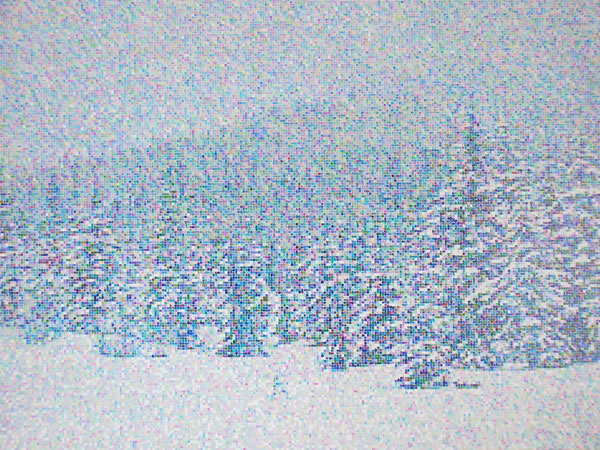A series of workshop materials and links to extend simple digital skills into an approach to data for developing art practices at LICA. Rather than teach digital tools we might know about or can buy and learn elsewhere like Photoshop, this is an easy introduction to the idea of manipulating 'data' or information for creative ends.
You can find the Class content online here
Read about why I think we should think about data below
We are going to use in-browser tools made by the excellent multimedia designer/technologist Georg AKA 'Snorpey' that let you manipulate images including links to all the javascript code that made them, shared on the popular code sharing platform, github.
OpesSCAD is a tool for making 3D and 2D shapes with data and code. Like many things, there's now a version that runs in a webpage. So we are going to use OpenJSCAD (javascript implementation of OpenSCAD) in the browser and lets you save .stl files, the 3d printing standard
Data does not have to be big. 'll experiment generating data via observation and drawing.
Thinking of data as a practice means you can make present and manipulate text and images in interactive ways. Basic HTML and JavaScript and basic coding.
Make images, sound, play with the sound and turn back to images with Audacity.
Usually all the data stuff when we make digital images or video happens behind the scenes so you never think about it and for good reason; if you want to manipulate images in creative ways you often just want instant results. Then you can get on with the important stuff of making work.
Computer scientists have abstracted all the data stuff away so you can use it as a tool which is all good. However, thinking on a simple level of how a digital image is made up of individual 'pixels' with numbers assigned to it has it's advantages. When images are turned into a list of numbers; into data with a very specific schema or format, they can be 'translated' and manipulated in powerful ways. Just thinking of an image like this gives you access to a literacy in what your tools are actually doing which could lead to you making your own tools or using your existing ones in new ways. And literacy can lead to the intuition and development we often need in our art practices.
In many ways a digital image is not an image at all but more like an abstract 'spatial' map of related coordinates and numbers in a colour space that use a format or schema that other people and machines know about so they can be shared on phones, projectors, monitors, or inkjet printers.
So our image data 'maps', can be read into other formats just as someone drawing will map visual experience to marks on paper; images can be turned into sound, manipulated as if they were so and translated back into images.
You can also make up data that's not referring to sound or colour but perhaps record experiences or find data online.
This is a series of exercises to show that doing that is not that difficult.
Want to find out more about learning this kind of practice it's well worth starting out with Processing. Initially check out Dan Shiffman's (Processing inventor) Highly Enthusiastic video.
Then browse the work of a huge community of artists and creatives on the Open Processing site which lets you get coding straight away in the browser without downloading anything. You can then move onto downloading to your own computer.
Then if you want to make physical sensors to generate data it's worth checking out artist Laura Pullig's workshop tutorial called What Does Health Look Like using Processing and the BBC Microbit a £15 computer system for learning Physical computing.
Example established artistic practices that use data
Rosa Menkman "vernacular of file formats"Nick Briz "glitch codec tutorial" video
Takeshi Murata "pink dot"
Phillip Sterns "glitch textiles"
Dan Hays work hand takes the abstracted cartesian 'image maps' back to their material artefacts through hand painting pixels. Ironic that programmers spend years on the data architecture of images for convenience only for the image makers to un-convenience it almost in protest.
Sam Meech makes very interesting takes on very simple digital images and translates them with knitting machines, video, performance and interaction
James Bridle is a journalist and artist uncovering the infrastructure of our now ubiquitous data culture.
Forensic Architecture famously won the 2018 Turner Prize and challenge what artists (or architects) are meant to do at all
Julian Oliver started out doing high end yet philosophically straightforward media-interaction work like Fijuu which I curated back in 2008, to developing the Critical Engineering Manifesto and making work and projects on the edge of speculative design and tools for network activism.
Lucy Kimbell Artist and researcher, writer and strategic design in social innovation. Considering and participating in wider data cultures can help sustain an artistic practice
Directory of data artists Big Bang Data Project at Somerset House
Ellie Harrison, a self confessed recovering data addict who has been recording how much she swims every day for years until she swims the atlantic. Also famously connected a vending machine to austerity data, campaigns to Bring Back British Rail and got roasted by the Daily Record for an Arts Council Funded Project for her to only work within the Greater Glasgow Strathclyde region to reduce her carbon footprint.
Sam Thulin does a Data Sensor Drone-By











